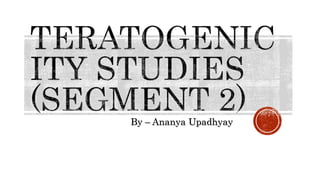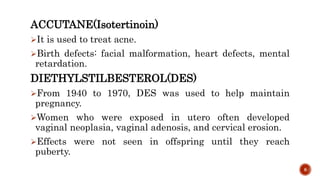This document provides an overview of teratogenicity and developmental toxicity. It discusses the mechanisms by which teratogens act, including folate antagonism and neural crest cell disruption. It outlines principles such as critical periods of susceptibility and covers historical teratogens like thalidomide and accutane. The document also reviews FDA drug categories during pregnancy and OECD testing guidelines for developmental toxicity studies in animals.








![ALCOHOL
Heavy drinking during the early pregnancy greatly
increases the risk of cluster of birth defects known as fetal
alcohol syndrome.
Fetal alcohol syndrome:
• This syndrome includes a small skull [microcephaly],
abnormal facial features, and heart defects, often
accompanied by impeded growth and mental retardation.
• Signs and symptoms: poor body weight, poor memory,
learning disabilities, speech and language delay, difficulty
with attention.
9](https://image.slidesharecdn.com/teratogenicanu-3-230423091559-db1328f6/85/teratogenic-anu-3-pptx-9-320.jpg)














